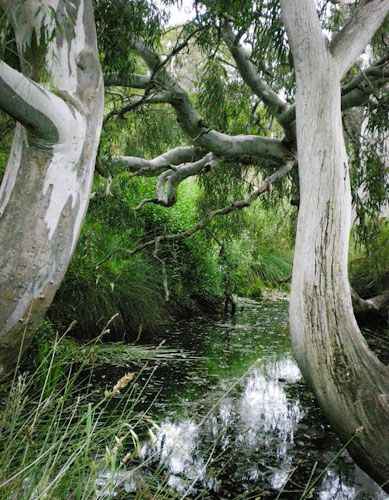|
Back to Factsheets | Download PDF |
River Red Gum
EUCALYPTUS CAMALDULENSIS
Family: Myrtaceae
Genus: Eucalyptus- well covered (pertaining to the gumnut having a cap or operculum)
Species: camaldulensis – named from a cultivated specimen growing in a garden of Camaldulian order of religious hermits named from St Roumald’s chief foundation colony at Camaldoli in Tuscany Italy.
Description
Medium to tall spreading woodland tree to 30m tall. Some individual trees can spread to 40m wide. In the upper barwon region, river red gum grows along the barwon river and surrounding flood plain.
Habitat
It appears that the natural southern boundary of red gum is near ingelby between birregurra and winchelsea. Anecdotally, the red gums growing at the birregurra golf course are planted specimens. Red gum grows in most riparian especially clays but also deep sands or silts with clay subsoils.
They produce profuse amounts of nectar rich flowers. Seed production is rapid (as little as 4 months from flower to seed) compared with most eucalypts and is not held on the tree for more than one season. The barwon provenance is not known for growing well in saline soil conditions. Studies show that trees can survive flooding for up to two years without any detrimental effects unless the water is salty.
Evolution
Red gum has learned to survive with flooding and very poor drainage.
-They are able to “breathe” through the trunk and can develop floating root masses that utilise oxygen from the air during inundation.
-They can survive drought with extensive “sinker” roots tapping into deep groundwater. They also shed leaves in drought to reduce transpiration.
-
Even young seedlings have aerenchymatous roots (air spaces in tissue to help waterlogged roots reach oxygen).
-
Seed drop usually occurs in spring which coincides with floods and warm conditions suitable for germination.
-
Some studies show allelopathy may be the reason why very little grows under red gum. Other studies suggest the shading and water competition from the mature gums to be the reason.
-
Red gum can be attacked by leaf chewing insects. Forest flooding can be a key factor in controlling the gum leaf skeletoniser moth (a major pest). The flooding provides favourable conditions for the growth of fungal pathogens of the moth as well as removing pupation sites and drowning larvae.
-
Red gum has evolved to take advantage of flooding but not with fire, as most other gums have. They have no lignotuber and even low intensity fires may cause damage to the cambium.
Uses
-Culturally significant for indigenous australians. Canoes produced from red gum bark which unlike other species can withstand the weather without curling or cracking.
-Sap
is used for healing burns; leaves used in steam baths.
-
The wood has been used for heavy construction, sleepers, veneering, firewood and charcoal.
-It is a very valuable honey tree as it produces pollen in vast quantities and is one of our heaviest yielders of nectar. Honey is mild, clear, straw coloured and a very good flavour.
Environment
-Very important plant for revegetation on watercourses and floodplains along the barwon.
-
Old trees, especially those with hollows (incl dead trees) are important habitat trees for wildlife especially on the basalt plains where faunal habitat is no longer contiguous.
-
For your firewood supply consider using plantation sugar gum instead of naturally occurring red gum.
References: Csiro ‘Water for a healthy country’ program www.anbg.gov.au/wfhc
Riverina Environmental Education Centre http://www.reec.nsw.edu.au
Koorie plants, Koorie people; Gott and Zola; Koorie Heritage Trust 1992
Honey flora of victoria; archives, vic dept of ag.
Australian plant genera; Baines; sgap
Forest trees of australia; Boland etc; CSIRO, 1984
|







